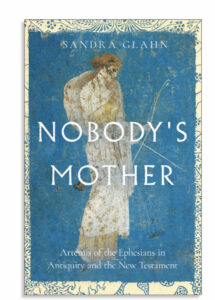About the book:
 Bible exposition and history
Bible exposition and history
Nobody’s Mother: Artemis of the Ephesians in Antiquity and the New Testament by Sandra Glahn
Downers Grove, IL: InterVarsity Press, 2023.
Available at Logos and IVP
Based on groundbreaking research and new data about Artemis of the Ephesians, Nobody’s Mother demonstrates how better background information supports faithful interpretation. Combining spiritual autobiography with scholarly exploration, Glahn takes readers on a journey to ancient Ephesus and across early church history. Unveiling the cult of Artemis and how early Christians related to it can give us a clearer sense of the type of radical, countercultural fellowship the New Testament writers intended Christ’s church to be.
* * *
Review:
What if I told you that everything you knew about Artemis of the Ephesians was wrong?
Well, Sandra Glahn has set out to show that there is more to Artemis than you read in your standard study Bible.
My interest in this area is pricked by the fact that my doktorvater Rick Strelan wrote his own thesis on Paul, Artemis and the Jews of Ephesus, so I knew about some of the debates. In addition, the cult of Artemis is definitely a big deal for the first Christians in Ephesus according to Acts 19. Also, as many of us have suspected, the Artemis cult somehow forms the background to the heresy in Ephesus which calls for Paul’s response in 1 Timothy 2:11-15.
The blurb is a good summary of the book:
Based on groundbreaking research and new data about Artemis of the Ephesians, Nobody’s Mother demonstrates how better background information supports faithful interpretation. Combining spiritual autobiography with scholarly exploration, Glahn takes readers on a journey to ancient Ephesus and across early church history. Unveiling the cult of Artemis and how early Christians related to it can give us a clearer sense of the type of radical, countercultural fellowship the New Testament writers intended Christ’s church to be.
A few things I learned.
First, Artemis was not a fertility goddess, she was associated in fact with celibacy and virginity, also with the Amazonian women, hunting, healing, and child-birth. Glahn gives a good summary of primary sources: “Putting this all together, one can see the rationale for Artemis being a goddess of midwifery while also being a virgin in the strictest sense. She is not a mother or a nurturer or a fertility goddess. She is a virgin goddess specializing in several things, including the painless delivery or painless deaths, especially related to childbearing” (54).
Second, “saved through child-bearing” in 1 Tim 2:15 is probably a local saying to the effect that Jesus not Artemis is the patron saint of pregnant women. In any case, it is further proof that Paul was dealing with a local issue when writing 1 Tim 2:11-15.
Anyways, insights like that and more are to be found in the book.
Strongly recommended for anyone interested in the cultural background of the New Testament or wrestling with 1 Timothy 2:11-15.
~ Michael F. Bird, Australian biblical scholar and priest who writes about the history of early Christianity, theology, and contemporary issues.
* * *

Dr. Sandra Glahn
Sandra L. Glahn (PhD, University of Texas at Dallas) is professor of media arts and worship at Dallas Theological Seminary, where her emphases are first-century backgrounds related to women, culture, gender, and the arts. She has authored or edited more than twenty books, including Vindicating the Vixens, Earl Grey with Ephesians, Sanctified Sexuality(coeditor), and Sexual Intimacy in Marriage (coauthor).


